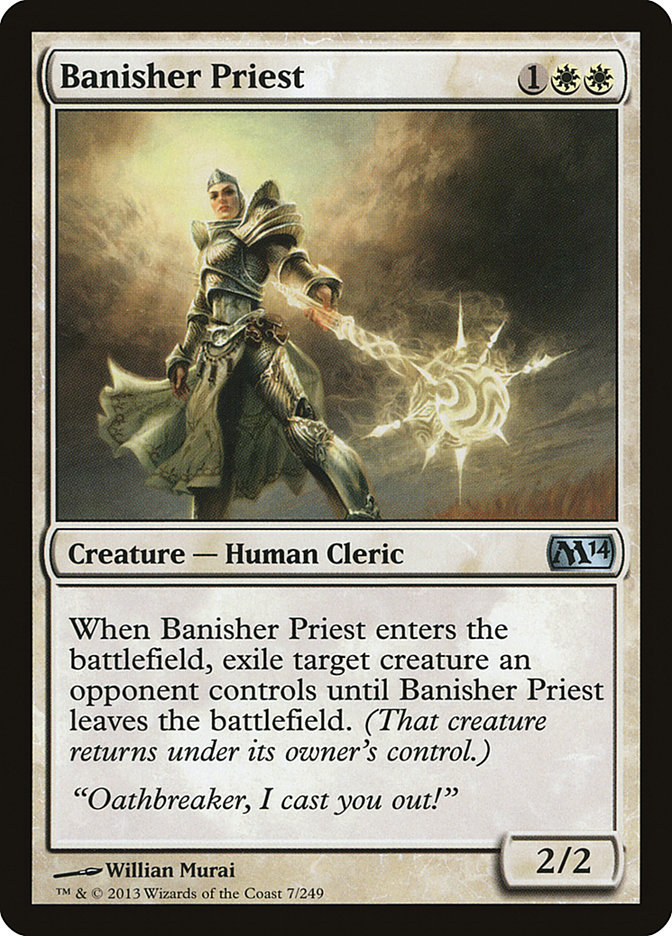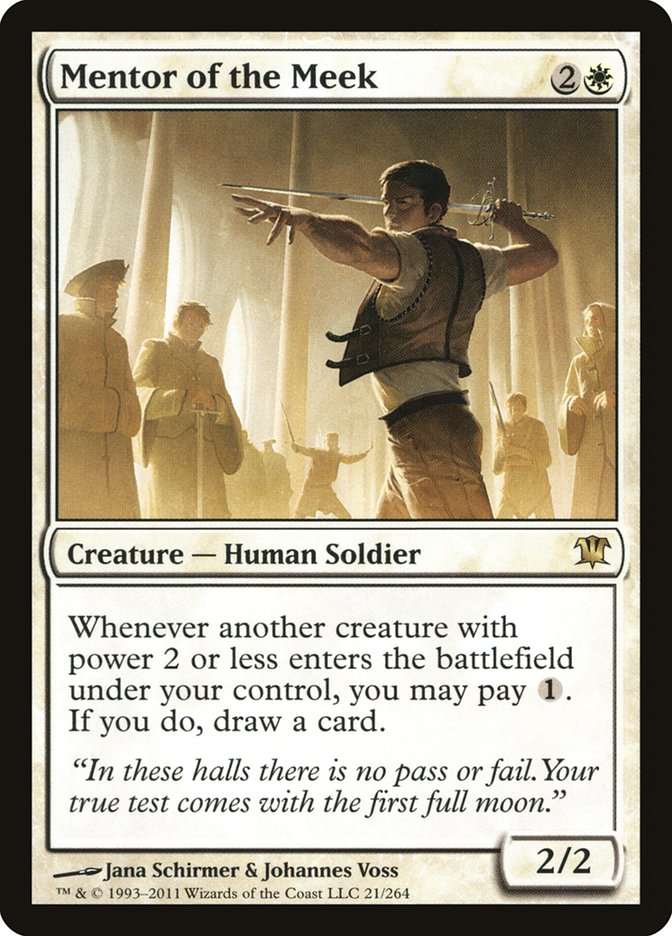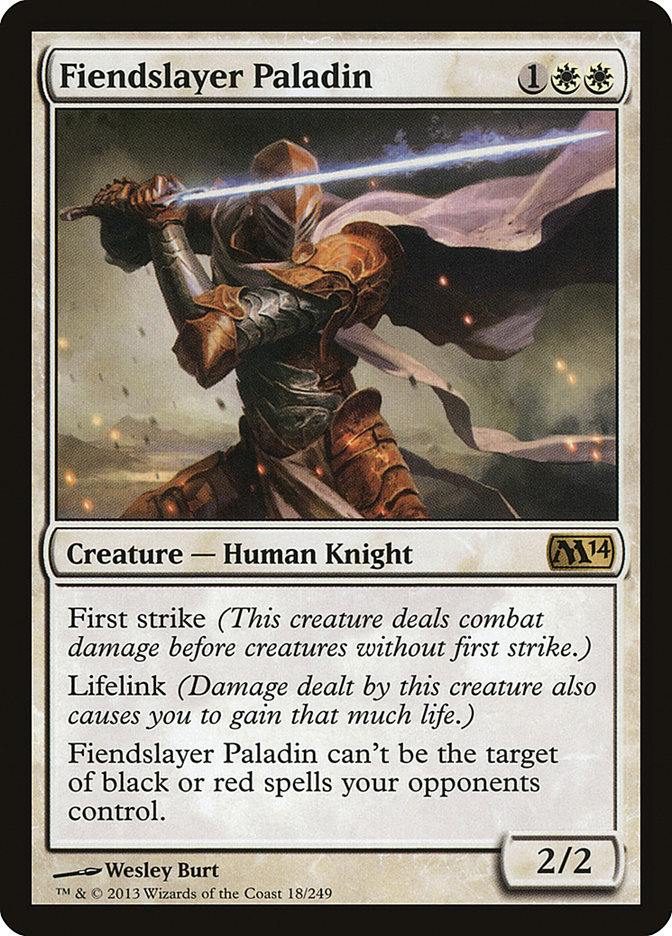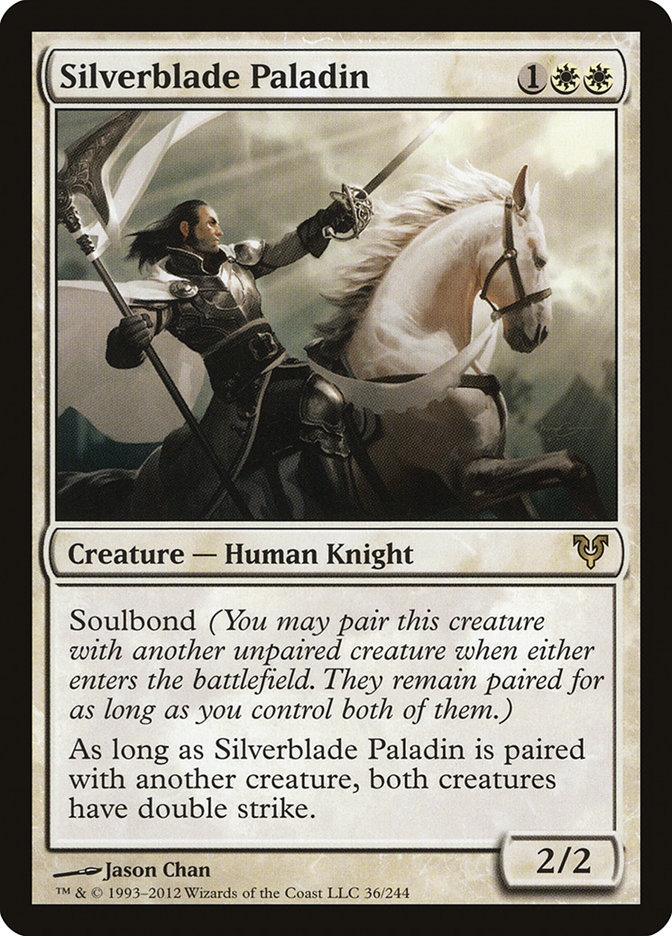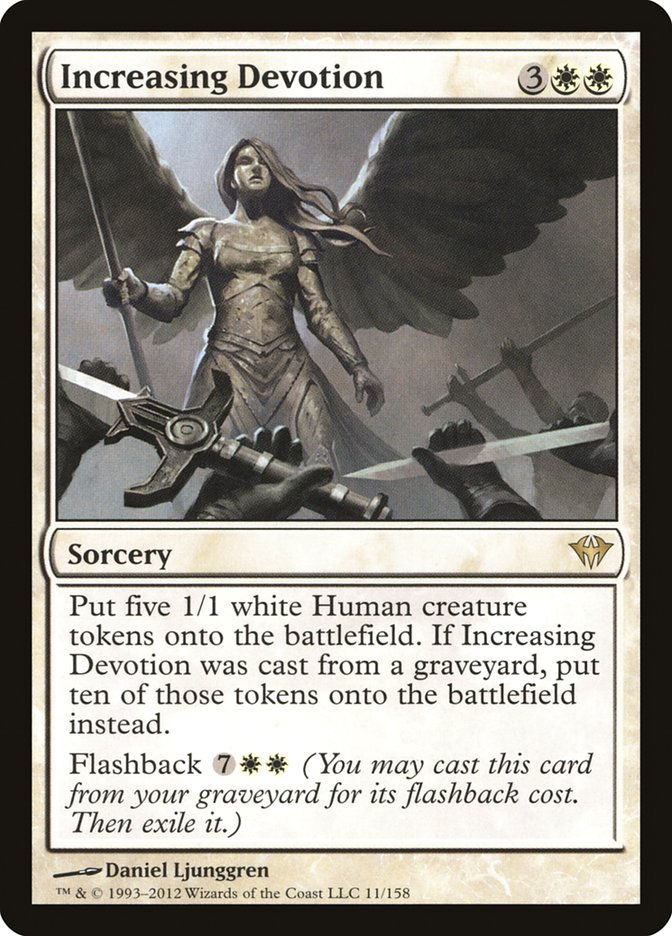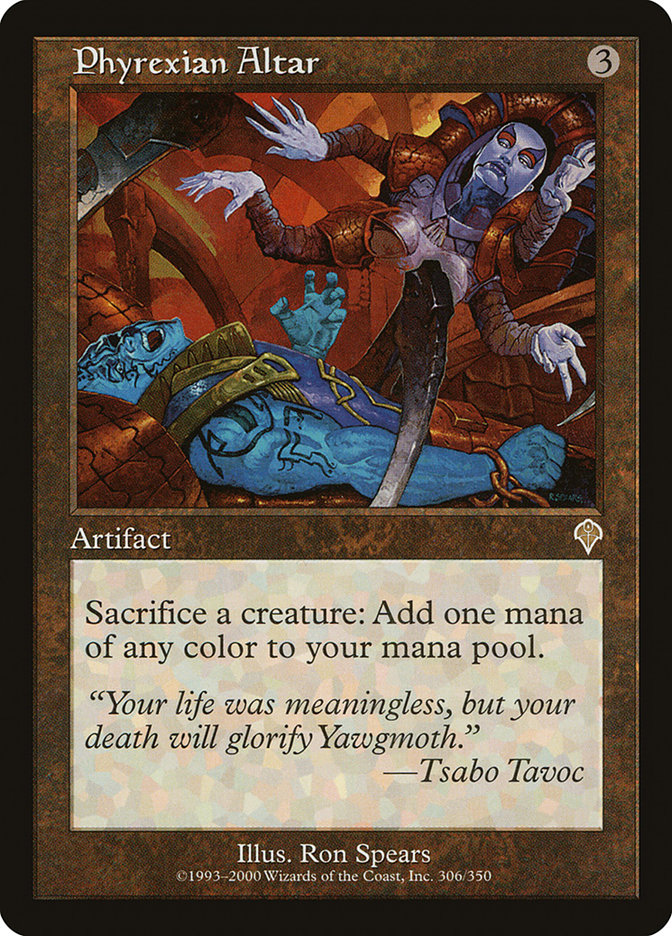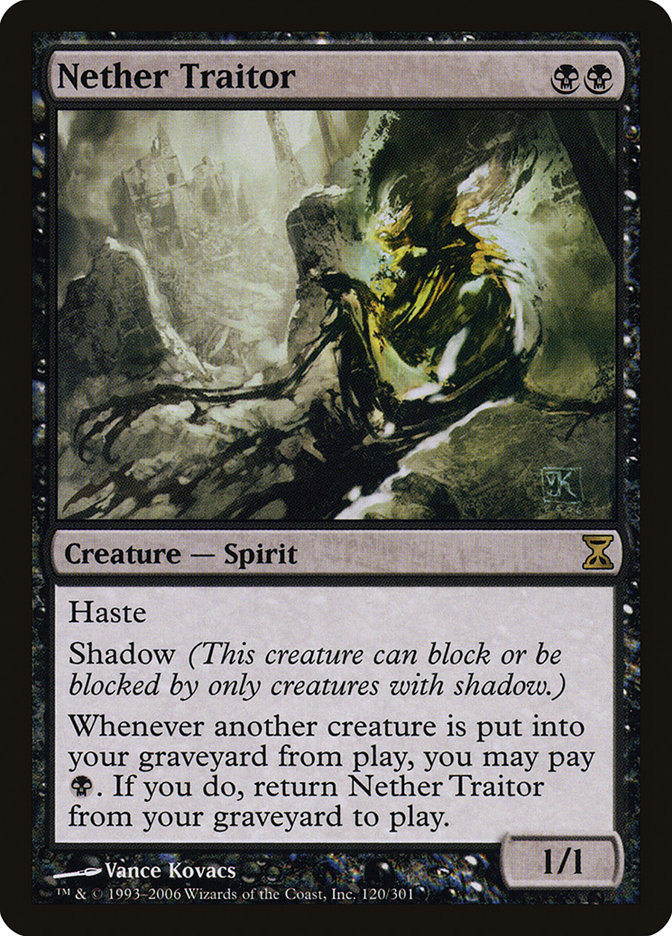This will not be my attempt to follow up on AJ Sacher popular lessons on exactly when to cast Brainstorm in Legacy. This will be a place for me to discuss a bunch of ideas I have across Standard, Modern, and Legacy, all of which are still in their infancy. Let’s build some decks!
Standard
The W/B Humans shell is one of the cores people are most excited about. It gains any combination of Imposing Sovereign, Banisher Priest, Fiendslayer Paladin, Xathrid Necromancer, and Lifebane Zombie. With so many new cards, it’s unclear whether this will want a third color. On one hand, the lands in Standard easily allow for one. On the other hand, it will cost at least a few life per game on average, and there may simply be enough to work with in two colors.
One thing I’ve noticed is that with the addition of Xathrid Necromancer the deck easily blurs the line between being a “Human” deck and being a “token” deck, and I think I haven’t seen as many Intangible Virtues in these lists as people should probably be playing. With that in mind, the core I want to start with is:
4 Champion of the Parish
4 Doomed Traveler
4 Cartel Aristocrat
4 Gather the Townsfolk
4 Lingering Souls
4 Xathrid Necromancer
There are other cards I’m sure about, but let’s pause there. I’m imagining that this deck will have some number of Intangible Virtues and Sorin, Lord of Innistrads, which is why I’m comfortable including Gather the Townsfolk among the core cards. With Champion of the Parish, Intangible Virtue, and Xathrid Necromancer, it just has enough support that it should routinely be awesome.
At this point, I want to take a moment to examine what the deck’s doing. Without Silverblade Paladin or Falkenrath Aristocrat, it’s lacking the explosive damage of the original Aristocrats, and without Blasphemous Act / Boros Reckoner / Blood Artist, it’s lacking the combo finish. Fundamentally, I think this deck plays much more like Junk Aristocrats, just trying to get value all over as it grinds the opponent out with small creatures.
Blood Artist is incredible if that’s your goal and is pretty clearly awesome with the shell I’ve started with. My only concern is that I’m only sure about four sacrifice outlets, which I’m not sure is enough to make Blood Artist do what I want it to. Let’s consider where we can go from here.
If we want more one-drops, the next option is Boros Elite. Given that it’s the best available, I don’t think we want more one-drops badly enough.
At two, the options are Imposing Sovereign, Intangible Virtue, Blood Artist, Bloodthrone Vampire, Skirsdag High Priest, and potentially Knight of Glory / Knight of Infamy. I think those are written in roughly descending order of how much I like them. I’m not sure what the optimal number of Imposing Sovereigns is since we’re not quite as aggressive as you’d optimally like to be with the card and drawing two isn’t great since the effect is redundant. But it’s still extremely powerful, and we’re not that poorly suited to taking advantage of it. Intangible Virtue is similarly a card I know I want but don’t know how many; I know it’s at least two and suspect it should be four, but I’m not sure.
The more Vampires we add, the more we water down both our token and our Human theme, so I’m kind of afraid of going that direction. I’d only want Bloodthrone Vampire to support Blood Artist and don’t really think there’s room for both. This looks a lot like the decks where I strongly advocate Skirsdag High Priest, but I don’t think we can do it without more sacrifice outlets and we already have access to the kind of overwhelming forces it offers. I’m remarkably low on that card in this shell. The Knights are there if we want to go a little more aggressive, but I think they’re largely at odds with the Intangible Virtue direction that I prefer.
We already have close to as many threes as we’d really want, but there are some that are worth talking about.
I’m pretty confident that Banisher Priest is a bad Fiend Hunter. The fact that you can’t sacrifice it with the trigger on the stack to permanently exile something definitely matters, and the stats aren’t what you want on that creature. You’re not looking to trade because you want their guy exiled as long as possible. You want to remove their Flinthoof Boar and block their Burning-Tree Emissary. It’s much worse if you can only do one of those things. You also don’t want them to use cheap removal on it, so the third toughness to get out of range of Pillar of Flame matters. I really can’t imagine a deck that would be aggressive enough that I’d ultimately want to go the other way, but I can imagine being tempted.
As for whether we want Fiend Hunter, I haven’t discussed any removal yet, but it’s likely we want some and this is a reasonable option to get some without diluting our strategy.
The grindy direction we’re going has me really curious about Mentor of the Meek, but that might be too much of a good thing in that it might just make us better when our strategy is good and worse when it’s bad, which likely isn’t where we want to be. I’d definitely start with one or two in the sideboard though.
Fiendslayer Paladin feels pretty out of place to me without anything to increase its power. I’m pretty sure this isn’t the home it’s looking for.
Silverblade Paladin is still on the table. Turn 1 Champion of the Parish, turn 2 Imposing Sovereign, turn 3 Silverblade Paladin is a really good sequence since you’re likely hitting them for eight that turn, which really puts them on the back foot. The problem is any game where you don’t draw Champion of the Parish.
(Obligatory mention that I haven’t forgotten Sin Collector, who is sweet in this deck; I just want it in the sideboard.)
At four, it’s hard to compete with Sorin, Lord of Innistrad, but one should never really write off Restoration Angel. The only other four-mana spell I can think of that I’d realistically consider is Sever the Bloodline.
At five, in B/W I think Obzedat, Ghost Council is the best option. This would basically be there for when plan A fails since it’s an awesome plan B by itself and our plan A bridges very well for it to take over. It’s very possible that in reality this is an “Obzedat and some distractions” deck that wants to play three Obzedats. That sounds pretty awesome to me.
The next best option is probably Increasing Devotion. If you have Xathrid Necromancer in play and you cast Increasing Devotion, your opponent is in a really rough spot, especially if Intangible Virtue or Blood Artist is involved because they can’t play a sweeper without killing the Necromancer or they’ll just die to your Zombies. If you have a sac outlet with the Blood Artist, they’re probably just dead on the spot. This option is tempting if we’re really committing to the token plan and/or playing Blood Artist.
For removal, I think Fiend Hunter, Sever the Bloodline, and Orzhov Charm are the best options. I don’t like Tragic Slip because I don’t think we have enough control over morbid. Doom Blade is reasonable, but I like killing anything. And when we have this many Humans, rebuying a Champion of the Parish is a very relevant option.
I think I want to start with the Obzedat, Ghost Council and friends mentality, so look at:
Creatures (20)
- 4 Champion of the Parish
- 4 Doomed Traveler
- 3 Obzedat, Ghost Council
- 4 Cartel Aristocrat
- 1 Imposing Sovereign
- 4 Xathrid Necromancer
Planeswalkers (2)
Lands (24)
Spells (13)
Sideboard

I’d definitely be interested in playing more than one Imposing Sovereign, but it’s hard to find space. It might be that the third Obzedat, Ghost Council is too much, but I want to start with the theory that it’s what’s really going on in this deck. As for the sideboard, Blood Artist is the best thing against any other Cartel Aristocrat deck. I think Fiend Hunter is what I want against aggressive decks and green decks, but that might be wrong, especially if the green decks have a lot of Garruk Relentless.
Sin Collector is obviously good against control as always. Lifebane Zombie shores up a considerable Angel of Serenity problem and a potential Craterhoof Behemoth issue. Mentor of the Meek is good against control as a threat they have to deal with immediately and anyone without removal who you think will give you any time (Reanimator?). Duress is another Sin Collector that’s friendlier on the curve, and Orzhov Charm is a tuning card/out to Olivia Voldaren.
The most likely cards this sideboard is missing are more cheap removal spells and the third Intangible Virtue. Fiend Hunter is the sideboard card I’m least confident in.
Modern
I’ve been toying around with the idea of a five-color Human deck in Modern that could take advantage of a mana base along the lines of:
4 City of Brass
4 Gemstone Mine
4 Cavern of Souls
4 Reflecting Pool
4 Ancient Ziggurat
I’m pretty sure we’d want to include Noble Hierarch, Champion of the Parish, Dark Confidant, Imposing Sovereign, and non-Human Geist of Saint Traft. My first attempt used a Snapcaster Mage package, Grim Lavamancer, and Ranger of Eos, but I’m less confident in that part of the deck. When a deck can cast Ash Zealot roughly as easily as Meddling Mage or Auriok Champion, it becomes a little difficult to process exactly which Humans you want. Also, Paul Rietzl G/W deck has me wondering if this deck would want Aether Vial, particularly with Snapcaster Mage.
With Snapcaster Mage, the spells I’d want to consider are Lightning Bolt, Gut Shot, Gitaxian Probe, Thought Scour, Path to Exile, and Vapor Snag, with Thoughtseize and possibly Negate in the sideboard.
The same mana base can also support a Sliver creature base. Galerider Sliver is the main reason this is interesting to me, as I think that card is just a really big deal that hasn’t be talked about much. That would probably look like:
Creatures (28)
- 4 Spined Sliver
- 4 Sidewinder Sliver
- 1 Darkheart Sliver
- 4 Sinew Sliver
- 1 Bonescythe Sliver
- 4 Blur Sliver
- 4 Predatory Sliver
- 4 Galerider Sliver
- 2 Syphon Sliver
Lands (20)
Spells (12)
Sideboard

Legacy
I’ve been thinking about playing a different deck instead of my Zombie deck lately because I’ve started to have a real problem with Deathrite Shaman, which has gotten very popular. Now I’m wondering if I’m giving up too easily instead of reworking things more substantially.
Specifically, I find myself siding out all twelve Zombies (Carrion Feeder, Gravecrawler, and Tidehollow Sculler) pretty often and wanting removal a lot these days because of Deathrite Shaman, and I wonder if the core of the deck should just be built without the Zombies.
I also might not be doing enough to take advantage of the fact that I can play my own Deathrite Shamans. Specifically, I wonder if I should be playing Careful Study. Also, Liliana of the Veil was terrible when I first tested the deck with her, but Deathrite Shaman might completely change that.
The issue with cutting Gravecrawler and adding Careful Study is that I worry about not having enough cards I want to discard to all these effects. One possible solution is to play Nether Traitor, which I’ll always want to discard. The problem is that Nether Traitor is usually relatively mana intensive and low impact; however, it can get absurd with Phyrexian Altar, which is another card that I need to reevaluate with Deathrite Shaman because three mana is much more reasonable. To really get anything out of Phyrexian Altar / Nether Traitor I’d need another combo piece, like Blood Artist, but I’m not unhappy to play that card anyway.
I could also just move Dark Confidant to the main with some Lightning Bolts and maybe Liliana of the Veil and turn into a “regular deck” that happens to have Bloodghast / Faithless Looting / Lingering Souls / Goblin Bombardment.
I could get crazier and instead of Lightning Bolt and Liliana of the Veil play Benevolent Bodyguard and Skirsdag High Priest. Testing each of these directions will take a lot of work, but this is included partially as a larger comment on how we understand decks.
I’ve heard people say that there’s not a lot of room to change this deck or any other heavily synergy-driven deck around, but in my experience that’s rarely true, especially in Legacy where there are so many analogous cards. I often find myself gutting the core of a deck and rebuilding it around some of the fringe or support cards (this happened many times while building The Aristocrats, for example), and I think it’s something other people are often too hesitant to do. Don’t get too attached to a central idea. When you’re working on something, it’s important to keep an open mind and let the process lead you in unforeseen directions.
Thanks for reading,
Sam
@samuelhblack on Twitter
twitch.tv/samuelhblack

